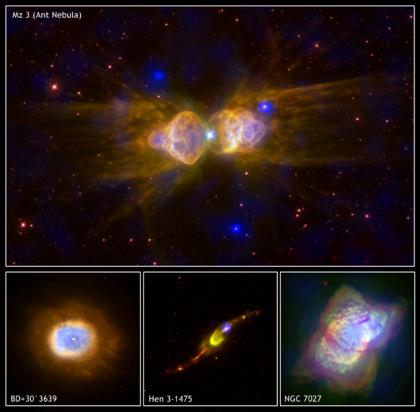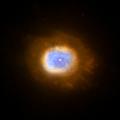Mz 3:
Planetary Nebulas - Fast Winds from Dying Stars
 Credit: X-ray: NASA/CXC/RIT/J.Kastner et al.; Optical/IR: BD +30 & Hen 3: NASA/STScI/Univ. MD/J.P.Harrington; NGC 7027: NASA/STScI/Caltech/J.Westphal & W.Latter; Mz 3: NASA/STScI/Univ. Washington/B.Balick
Credit: X-ray: NASA/CXC/RIT/J.Kastner et al.; Optical/IR: BD +30 & Hen 3: NASA/STScI/Univ. MD/J.P.Harrington; NGC 7027: NASA/STScI/Caltech/J.Westphal & W.Latter; Mz 3: NASA/STScI/Univ. Washington/B.Balick
This panel of composite images shows part of the unfolding drama of the last stages of the evolution of sun-like stars. Dynamic elongated clouds envelop bubbles of multimillion degree gas produced by high-velocity winds from dying stars. In these images, Chandra's X-ray data are shown in blue, while green and red are optical and infrared data from Hubble.
Planetary nebulas — so called because some of them resemble a planet when viewed through a small telescope — are produced in the late stages of a sun-like star's life. After several billion years of stable existence (the sun is 4.5 billion years old and will not enter this phase for about 5 billion more years) a normal star will expand enormously to become a bloated red giant. Over a period of a few hundred thousand years, much of the star's mass is expelled at a relatively slow speed of about 50,000 miles per hour.
This mass loss creates a more or less spherical cloud around the star and eventually uncovers the star's blazing hot core. Intense ultraviolet radiation from the core heats the circumstellar gas to ten thousand degrees, and the velocity of the gas flowing away from the star jumps to about a million miles per hour.
This high speed wind appears to be concentrated into opposing supersonic funnels, and produces the elongated shapes in the early development of planetary nebulas (BD+30-3639 appears spherical, but other observations indicate that it is viewed along the pole.) Shock waves generated by the collision of the high-speed gas with the surrounding cloud create the hot bubbles observed by Chandra. The origin of the funnel-shaped winds is not understood. It may be related to strong, twisted magnetic fields near the hot stellar core.
| Fast Facts for Mz 3: |
| Credit |
X-ray: NASA/CXC/RIT/J.Kastner et al.; Optical/IR: BD +30 & Hen 3: NASA/STScI/Univ. MD/J.P.Harrington; NGC 7027: NASA/STScI/Caltech/J.Westphal & W.Latter; Mz 3: NASA/STScI/Univ. Washington/B.Balick |
| Scale |
Image is 110 x 75 arcsec |
| Category |
White Dwarfs & Planetary Nebulas |
| Coordinates (J2000) |
RA 16h 17m 12.60s | Dec -51° 59´ 08.00" |
| Constellation |
Norma
|
| Observation Dates |
April 1, 2004 |
| Observation Time |
11 hours |
| Obs. IDs |
4954
|
| Color Code |
Energy (X-ray: Blue; Optical/IR: Red & Green) |
| Instrument |
ACIS |
| Also Known As | Menzel 3, Ant Nebula |
| References |
J. Kastner et al. 2003, Astrophys. J. 591, L 37 |
| Distance Estimate |
About 3,000 light years
|
| Release Date |
May 10, 2006 |
|
| Fast Facts for BD+30-3639: |
| Credit |
X-ray: NASA/STScI/Univ. MD/J.P.Harrington |
| Scale |
Image is 18 arcsec |
| Category |
White Dwarfs & Planetary Nebulas |
| Coordinates (J2000) |
RA 19h 34m 45.20s | Dec +30° 30´ 59.10" |
| Constellation |
Cygnus
|
| Observation Dates |
2000-03-21 |
| Observation Time |
5 hours |
| Obs. IDs |
587
|
| Color Code |
Energy (X-ray: Blue; Optical/IR: Red & Green) |
| Instrument |
ACIS |
| Also Known As | Campbell's Star |
| References |
J. Kaster et al. 2000 Ap. J. 545, L 57 |
| Distance Estimate |
About 5,000 light years
|
| Release Date |
May 10, 2006 |
|
| Fast Facts for NGC 7027: |
| Credit |
NASA/STScI/Caltech/J.Westphal & W.Latter; |
| Scale |
Image is 18 arcsec |
| Category |
White Dwarfs & Planetary Nebulas |
| Coordinates (J2000) |
RA 21h 07m 01.60s | Dec +42° 14' 09.70" |
| Constellation |
Cygnus
|
| Observation Dates |
2000-06-01 |
| Observation Time |
5 hours |
| Obs. IDs |
588
|
| Color Code |
Energy (X-ray: Blue; Infrared: Red; Optical: Green) |
| Instrument |
ACIS |
| References |
J. Kastner et al. 2001, Astrophys. J. 550, L189 |
| Distance Estimate |
About 3,000 light years
|
| Release Date |
May 10, 2006 |
|
| Fast Facts for Hen 3-1475: |
| Credit |
X-ray: NASA/CXC/RIT/J.Kastner et al.; Optical: NASA/STScI/Univ. MD/J.P.Harrington |
| Scale |
Image is 18 arcsec |
| Category |
White Dwarfs & Planetary Nebulas |
| Coordinates (J2000) |
RA 17h 45m 14.20s | Dec -17° 56´ 47.00" |
| Constellation |
Sagittarius
|
| Observation Dates |
2002-07-15 |
| Observation Time |
14 hours |
| Obs. IDs |
2580
|
| Color Code |
Energy (X-ray: Blue; Optical/IR: Red & Green) |
| Instrument |
ACIS |
| References |
R. Sahai et al. 2003, Astrophys. J. 599, L87 |
| Distance Estimate |
About 18,000 light years
|
| Release Date |
May 10, 2006 |
|






